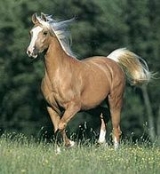
Cream gene
Encyclopedia

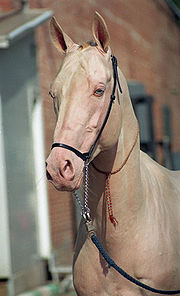
Horse
The horse is one of two extant subspecies of Equus ferus, or the wild horse. It is a single-hooved mammal belonging to the taxonomic family Equidae. The horse has evolved over the past 45 to 55 million years from a small multi-toed creature into the large, single-toed animal of today...
coat colors
Equine coat color
Horses exhibit a diverse array of coat colors and distinctive markings. A specialized vocabulary has evolved to describe them.While most horses remain the same color throughout life, a few, over the course of several years, will develop a different coat color from that with which they were born...
. Horses that have the cream gene in addition to a base coat color that is chestnut
Chestnut (coat)
Chestnut is a hair coat color of horses consisting of a reddish-to-brown coat with a mane and tail the same or lighter in color than the coat. Genetically and visually, chestnut is characterized by the absolute absence of true black hairs...
will become palomino
Palomino
Palomino is a coat color in horses, consisting of a gold coat and white mane and tail. Genetically, the palomino color is created by a single allele of a dilution gene called the cream gene working on a "red" base coat...
if they are heterozygous, having one copy of the cream gene, or cremello, if they are homozygous. Similarly, horses with a bay base coat and the cream gene will be buckskin or perlino. A black base coat with the cream gene becomes the not-always-recognized smoky black
Smoky black
Smoky black is a hair coat color of horses in which the coat is either black or a few shades lighter than true black. Smoky black is produced by the action of a heterozygous cream gene on an underlying black coat color...
or a smoky cream.
Cream horses, even those with blue eyes, are not white
White (horse)
White horses are born white and stay white throughout their life. White horses may have brown, blue, or hazel eyes. "True white" horses, especially those that carry one of the dominant white genes, are rare...
horses. Dilution coloring is also not related to any of the white spotting
Pinto
-General:*Conspiracy of the Pintos, a rebellion against Portuguese rule in Goa, India in 1787*Ford Pinto , a subcompact car manufactured by the Ford Motor Company for the North American market...
patterns.
The cream gene (CCr) is an incomplete dominant
Dominance relationship
Dominance in genetics is a relationship between two variant forms of a single gene, in which one allele masks the effect of the other in influencing some trait. In the simplest case, if a gene exists in two allelic forms , three combinations of alleles are possible: AA, AB, and BB...
allele with a distinct dosage effect. The DNA
DNA
Deoxyribonucleic acid is a nucleic acid that contains the genetic instructions used in the development and functioning of all known living organisms . The DNA segments that carry this genetic information are called genes, but other DNA sequences have structural purposes, or are involved in...
sequence responsible for the cream colors is the cream allele
Allele
An allele is one of two or more forms of a gene or a genetic locus . "Allel" is an abbreviation of allelomorph. Sometimes, different alleles can result in different observable phenotypic traits, such as different pigmentation...
, which is at a specific locus
Locus (genetics)
In the fields of genetics and genetic computation, a locus is the specific location of a gene or DNA sequence on a chromosome. A variant of the DNA sequence at a given locus is called an allele. The ordered list of loci known for a particular genome is called a genetic map...
on the MATP
SLC45A2
Membrane-associated transporter protein also known as solute carrier family 45 member 2 or melanoma antigen AIM1 is a protein that in humans is encoded by the SLC45A2 gene.-Function:...
gene. Its general effect is to lighten the coat, skin and eye colors. When one copy of the allele is present, it dilutes "red" pigment to yellow or gold, with a stronger effect on the mane
Mane (horse)
The mane is the hair that grows from the top of the neck of a horse or other equine, reaching from the poll to the withers, and includes the forelock or foretop. It is thicker and coarser than the rest of the horse's coat, and naturally grows to roughly cover the neck...
and tail, but does not dilute black color to any significant degree. When two copies of the allele are present, both red and black pigments are affected; red hairs still become cream, and black hairs become reddish. A single copy of the allele has minimal impact on eye color, but when two copies are present, a horse will be blue-eyed in addition to a light coat color.
The cream gene is one of several hypomelanism or dilution gene
Dilution gene
Dilution gene is a popular term for any one of a number of genes that act to create a lighter coat color in living creatures. There are many examples of such genes:-General:...
s identified in horse
Horse
The horse is one of two extant subspecies of Equus ferus, or the wild horse. It is a single-hooved mammal belonging to the taxonomic family Equidae. The horse has evolved over the past 45 to 55 million years from a small multi-toed creature into the large, single-toed animal of today...
s. Therefore, it is not always possible to tell by color alone whether the CCr allele
Allele
An allele is one of two or more forms of a gene or a genetic locus . "Allel" is an abbreviation of allelomorph. Sometimes, different alleles can result in different observable phenotypic traits, such as different pigmentation...
is present without a DNA test. Other dilution genes that may mimic some of the effects of the cream gene in either single or double copies include the pearl gene
Pearl gene
The Pearl gene, also known as the "Barlink factor," is a dilution gene that somewhat resembles the cream gene and the champagne gene, but is neither. It is a somewhat rare dilution gene found in the American Quarter Horse, American Paint Horse, and Peruvian Paso. The same mutation appears in...
, silver dapple gene
Silver dapple gene
The silver dapple gene is a dilution gene that affects the black base coat color. It will typically dilute a black mane and tail to flaxen, and a black body to a shade of brown or chocolate. It is responsible for a group of coat colors in horses called "silver dapple" in the west, or "taffy" in...
, and the champagne gene
Champagne gene
The champagne gene is a simple dominant allele responsible for a number of rare horse coat colors. The most distinctive traits of horses with the champagne gene are the hazel eyes and pinkish, freckled skin, which are bright blue and bright pink at birth, respectively...
. Horses with the dun gene
Dun gene
The dun gene is a dilution gene that affects both red and black pigments in the coat color of a horse. The dun gene has the ability to affect the appearance of all black, bay, or chestnut -based horses to some degree by lightening the base body coat and suppressing the underlying base color to the...
also may mimic a single copy of the cream gene. To complicate matters further, it is possible for a horse to carry more than one type of dilution gene, sometimes giving rise to coloring that researchers call a pseudo double dilute.
The discovery of the cream gene had a significant effect on breeding, allowing homozygous blue-eyed creams to be recognized by many breed registries that had previously registered palominos but banned cremellos, under the mistaken notion that homozygous cream was a form of Albinism
Albinism
Albinism is a congenital disorder characterized by the complete or partial absence of pigment in the skin, hair and eyes due to absence or defect of an enzyme involved in the production of melanin...
.
Colors produced

Chestnut (coat)
Chestnut is a hair coat color of horses consisting of a reddish-to-brown coat with a mane and tail the same or lighter in color than the coat. Genetically and visually, chestnut is characterized by the absolute absence of true black hairs...
, bay, and black
Black (horse)
Black is a hair coat color of horses in which the entire hair coat is black. Black is a relatively uncommon coat color, and novices frequently mistake dark chestnuts or bays for black. However, some breeds of horses, such as the Friesian horse, Murgese and Ariegeois are almost exclusively black...
. All horses obtain two copies of the MATP gene; one from the sire, and one from the dam. A horse may have the cream allele or the non-cream allele on each gene. Those with two non-cream alleles will not exhibit true cream traits. Horses with one cream allele and one non-cream allele, popularly called "single dilutes," exhibit specific traits: all red pigment in the coat is gold, while the black pigment is either unaffected or only subtly affected. These horses are usually palomino, buckskin, or smoky black. These horses often have light brown eyes. Horses with 2 copies of the cream allele also exhibit specific traits: cream-colored coats, pale blue eyes, and rosy-pink skin. These horses are usually called cremello, perlino, or smoky cream.
Heterozygous creams ("single dilutes")
Horses that are heterozygous creams, that is, have only one copy of the cream gene, have a lightened hair coat. The precise cream dilute coat color produced depends on the underlying base coat color. Unless also affected by other, unrelated genes, they maintain dark skin and brown eyes, though some heterozygous dilutes may be born with pink skin that darkens with age. Some have slightly lighter, amber eyes. However, the heterozygous cream dilute (CR) must not be confused with a horse carrying champagne dilutionChampagne gene
The champagne gene is a simple dominant allele responsible for a number of rare horse coat colors. The most distinctive traits of horses with the champagne gene are the hazel eyes and pinkish, freckled skin, which are bright blue and bright pink at birth, respectively...
. Champagne (CH) dilutes are born with pumpkin-pink skin and blue eyes, which darken within days to amber, green or light brown, and their skin acquires a darker mottled complexion around the eyes, muzzle, and genitalia as the animal matures. It is also possible for a heterozygous cream horse to carry more than one of the other dilution alleles. (see "Cream mimics," below) In such cases, they may exhibit some characteristics more typical of a homozygous dilute.
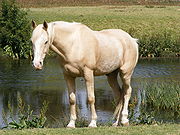
Palomino
Palomino is a coat color in horses, consisting of a gold coat and white mane and tail. Genetically, the palomino color is created by a single allele of a dilution gene called the cream gene working on a "red" base coat...
is the best known cream-based coat color, and is produced by the action of one cream allele on a chestnut coat. It is characterized by a cream or white mane and tail and yellow or gold coat. The classic golden shade akin to that of a newly minted gold coin is common, but there are other variations: the darkest shades are called sooty palominos, unusual but most often seen in Morgans
Morgan horse
The Morgan is one of the earliest horse breeds developed in the United States. Tracing back to the stallion Figure, later named Justin Morgan after his best-known owner, the breed excels in many disciplines, and is known for its versatility....
, can include a mane and tail with darker hairs and heavy dappling in the coat. The palest varieties can be nearly white, retaining darker skin and eyes, are sometimes mistakenly confused with cremello, and are called isabellas
Isabelline (colour)
Isabelline , sometimes called Isabella, is a colour, variously described as pale grey-yellow, pale fawn, pale cream-brown or parchment....
in some places.
Buckskin is also a well-known color, produced by the action of one cream gene on a bay coat. All red hairs in the base coat are diluted to gold. The black areas, such as the mane, tail and legs, are generally unaffected. The cream gene acting on a "blood bay" coat, the reddest shade, are pale gold with black points. They are sometimes called buttermilk buckskins. The cream gene acting on the darkest bays, (sometimes mistaken for seal browns) may dilute to a sooty buckskin. True seal brown
Seal brown (horse)
Seal brown is a hair coat color of horses characterized by a near-black body color; with black points, the mane, tail and legs; but also reddish or tan areas around the eyes, muzzle, behind the elbow and in front of the stifle...
buckskins can be very difficult to identify owing to their almost all-black coats. It is only the reddish markings around the eyes, muzzle, elbow and groin, which are turned gold, that may give them away.
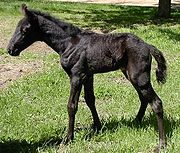
Smoky black
Smoky black is a hair coat color of horses in which the coat is either black or a few shades lighter than true black. Smoky black is produced by the action of a heterozygous cream gene on an underlying black coat color...
, a horse with a black base coat and one copy of the cream allele, is less well-known than the two golden shades. Since a single copy of the cream gene primarily affects red pigment, with only a subtle effect on black, smoky blacks can be quite difficult to identify. Smoky blacks may have reddish guard hairs inside their ears, and experienced horse persons may detect something "off" about the coat of a smoky black, though the slightly burnished look is often chalked up to sun bleaching, which can also be seen in true blacks. The palest can be mistaken for bays or liver chestnuts, especially if exposed to the elements. Smoky black coats tend to react strongly to sun and sweat, and many smoky blacks turn a chocolate color with particularly reddish manes and tails. Bleaching due to the elements means that the legs retain their color better, and can take on an appearance of having dark points like a bay horse. Smoky blacks, however, will lack rich red tones in the coat, instead favoring chocolate and orange tones. Because smoky blacks are often not recognized as such, breeders sometimes think that the cream gene "skipped" generations.
While there are "color breed
Color breed
A color breed is a term that refers to horses that are registered based primarily on their coat color, regardless of the horse's actual breed or breed type....
" registries for palomino and buckskin horses, which generally record horses based on apparent phenotype
Phenotype
A phenotype is an organism's observable characteristics or traits: such as its morphology, development, biochemical or physiological properties, behavior, and products of behavior...
and do not require a DNA color test, it is impossible for these colors to breed "true" due to the action of a single copy of the cream allele. Crossing two heterozygous dilutes will statistically result in offspring which are 25% the base color, 25% homozygous dilute, and 50% heterozygous dilute.
Homozygous creams ("double dilutes")
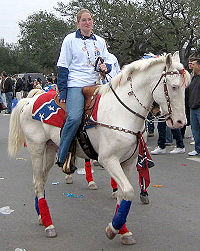
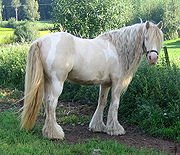
- Cremellos are homozygous cream chestnuts, and have a cream colored body with a cream or white mane and tail.
- Perlinos are homozygous cream bays, which also have a cream-colored body but a mane and tail that may be somewhat more reddish in color than a cremello.
- Smoky Creams are homozygous cream blacks, and very difficult to visually distinguish from cremellos or perlinos.
All three shades can be difficult to distinguish from one another, and are oftentimes only firmly identified after a DNA test. While both red and black pigments are turned cream, the black pigment retains a little more color and tends to have a reddish or rusty tint. Thus all-red coats are turned all-ivory, all-black coats are turned all-rusty cream, and bay coats have ivory bodies with slightly darker points.
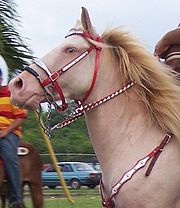
Horse markings
Markings on horses usually are distinctive white areas on an otherwise dark base coat color. Most horses have some markings, and they help to identify the horse as a unique individual. Markings are present at birth and do not change over the course of the horse's life...
, and the skin is rosy-pink. The true, unpigmented pink skin associated with white markings is clearly visible against the rosy-pink skin of a double-dilute, especially when their coat is wetted down. The palest shades of double-dilute coats are just off-white, while the darkest are distinctly rust-tinged. Their coats may be described as nearly white or ivory in addition to cream.
The off-white coat, pale blue eyes, and rosy pink skin distinguish the coats of double-dilutes from those of true white horses
White (horse)
White horses are born white and stay white throughout their life. White horses may have brown, blue, or hazel eyes. "True white" horses, especially those that carry one of the dominant white genes, are rare...
. True white horses have unpigmented skin and hair due to the incomplete migration of melanocytes from the neural crest during development.
No health defects are associated with the cream gene. This is also true of the normal variations in skin, hair and eye color encoded on the human MATP gene. True white coat coloring can be produced by at least half a dozen known genes, and some are associated with health defects. Some genes which encode a white or near-white coat when heterozygous, popularly called "dominant white," may be lethal in homozygote embryos. Another specific mutation on the endothelin receptor type B
Endothelin receptor type B
Endothelin receptor type B, also known as ETB is a protein that in humans is encoded by the EDNRB gene.- Function :Endothelin receptor type B is a G protein-coupled receptor which activates a phosphatidylinositol-calcium second messenger system. Its ligand, endothelin, consists of a family of three...
(EDNRB) gene is associated with the frame overo
Overo
Overo refers to several genetically unrelated pinto coloration patterns of white-over-dark body markings in horses, and is a term used by the American Paint Horse Association to classify a set of pinto patterns that are not Tobiano...
pattern produces Lethal white syndrome
Lethal white syndrome
Lethal white syndrome , also called overo lethal white syndrome , lethal white overo , and overo lethal white foal syndrome , is an autosomal genetic disorder most prevalent in the American Paint Horse...
if homozygous, but carriers can be identified with a DNA test.
Prevalence
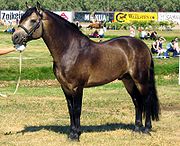
American Quarter Horse
The American Quarter Horse is an American breed of horse that excels at sprinting short distances. Its name came from its ability to outdistance other breeds of horses in races of a quarter mile or less; some individuals have been clocked at speeds up to 55 mph...
, Morgan
Morgan horse
The Morgan is one of the earliest horse breeds developed in the United States. Tracing back to the stallion Figure, later named Justin Morgan after his best-known owner, the breed excels in many disciplines, and is known for its versatility....
, American Saddlebred
American Saddlebred
The American Saddlebred, formerly known as the American Saddle Horse, is a breed of horse that was developed in Kentucky by plantation owners. Today, in the horse show world, they are most commonly seen under saddle in Saddle seat style riding, and in various types of driving, including pleasure...
, Tennessee Walking Horse, and Missouri Fox Trotter
Missouri Fox Trotter
The Missouri Fox Trotter is an American breed of horse with a unique four beat gait. It was bred in the Ozark Mountain foothills, and used by settlers who valued its smoothness.-Breed characteristics:...
. It is also seen in the Miniature horse
Miniature horse
Miniature horses are found in many nations, particularly in Europe and the Americas. The designation of miniature horse is determined by the height of the animal, which, depending on the particular breed registry involved, is usually less than as measured at the last hairs of the mane, which are...
, Akhal-Teke
Akhal-Teke
The Akhal-Teke is a horse breed from Turkmenistan, where they are a national emblem. They are noted for their speed and for endurance on long marches. These "golden-horses" are adapted to severe climatic conditions and are thought to be one of the oldest surviving horse breeds...
, Icelandic horse
Icelandic horse
The Icelandic horse is a breed of horse developed in Iceland. Although the horses are small, at times pony-sized, most registries for the Icelandic refer to it as a horse. Icelandic horses are long-lived and hardy. In their native country they have few diseases; Icelandic law prevents horses from...
, Connemara pony
Connemara pony
The Connemara pony is a pony breed originating in Ireland. They are known for their athleticism, versatility and good disposition. The breed makes excellent show ponies.-History:...
, and Welsh pony
Welsh Pony
The Welsh Pony and Cob are closely related horse breeds including both pony and cob types, which originated in Wales in the United Kingdom...
. It is even found in certain lines of Thoroughbred
Thoroughbred
The Thoroughbred is a horse breed best known for its use in horse racing. Although the word thoroughbred is sometimes used to refer to any breed of purebred horse, it technically refers only to the Thoroughbred breed...
s, Warmblood
Warmblood
Warmbloods are a group of middle-weight horse types and breeds, primarily originating in Europe, registered with organizations that are characterized by open studbook policy, studbook selection, and the aim of breeding for equestrian sport...
s, and the Lusitano
Lusitano
The Lusitano is a Portuguese horse breed, closely related to the Spanish Andalusian horse. Both are sometimes called Iberian horses, as the breeds both developed on the Iberian peninsula, and until the 1960s they were considered one breed, under the Andalusian name...
. The Andalusian horse
Andalusian horse
The Andalusian, also known as the Pure Spanish Horse or PRE , is a horse breed developed in the Iberian Peninsula. Its ancestors have been present on the Iberian Peninsula for thousands of years. The Andalusian has been recognized as an individual breed since the 15th century, and its conformation...
has conflicting standards, with the cream gene being recognized by some registries, but not explicitly mentioned by others. The cream gene is completely absent from the Arabian horse
Arabian horse
The Arabian or Arab horse is a breed of horse that originated on the Arabian Peninsula. With a distinctive head shape and high tail carriage, the Arabian is one of the most easily recognizable horse breeds in the world. It is also one of the oldest breeds, with archaeological evidence of horses...
genepool, and is also not found in breeds with stringent color requirements, such as the Friesian horse
Friesian horse
The Friesian is a horse breed originating in Friesland, Netherlands. Although the breed's conformation resembles that of a light draft horse, Friesians are graceful and nimble for their size. During the Middle Ages, it is believed that the ancestors of Friesian horses were in great demand as war...
.
Cream mimics
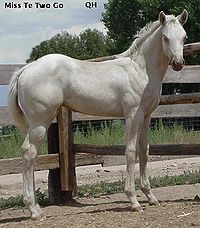
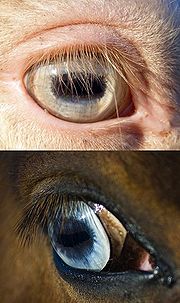
- Bay dun vs. Buckskin: the action of the dun geneDun geneThe dun gene is a dilution gene that affects both red and black pigments in the coat color of a horse. The dun gene has the ability to affect the appearance of all black, bay, or chestnut -based horses to some degree by lightening the base body coat and suppressing the underlying base color to the...
on bay produces a buckskin-like coat. Additional confusion occurs because in some countries, it is still customary to refer to buckskins as "dun", particularly in the British pony breeds. Bay duns tend to have a flatter coat color, more tan or peanut butter-colored than bronze, and also exhibit primitive markingsPrimitive markingsPrimitive markings among domestic horses are a group of hair coat markings and qualities associated with primitive breeds, and the dun coat color family in particular. All dun horses possess at least the dorsal stripe but the presence of the other primitive markings varies...
. - Amber champagne vs. Buckskin: the action of the Champagne geneChampagne geneThe champagne gene is a simple dominant allele responsible for a number of rare horse coat colors. The most distinctive traits of horses with the champagne gene are the hazel eyes and pinkish, freckled skin, which are bright blue and bright pink at birth, respectively...
on bay can also produce a buckskin-like coat. Champagnes can be identified by their freckled skin, hazel eyes, and chocolate (rather than black) points. - Flaxen chestnut vs. Palomino: Horses having light chestnut coats with flaxen manes and tails, such as those found in the HaflingerHaflinger (horse)The Haflinger, also known as the Avelignese, is a breed of horse developed in Austria and northern Italy during the late 19th century. Haflinger horses are relatively small, are always chestnut in color, have distinctive gaits described as energetic but smooth, and are well-muscled yet elegant...
breed, can be confused with palominos. However, unlike chestnuts, palomino is inherently a heterozygous condition and thus cannot be true-breeding. Furthermore, even the lightest chestnut will retain "red" character in the hair, rather than gold. - Gold champagne vs. Palomino: the action of the Champagne geneChampagne geneThe champagne gene is a simple dominant allele responsible for a number of rare horse coat colors. The most distinctive traits of horses with the champagne gene are the hazel eyes and pinkish, freckled skin, which are bright blue and bright pink at birth, respectively...
on chestnut was for many years called pumpkin-skinned palomino. However, lighter, freckled skin and hazel eyes identify a gold champagne, which can otherwise look much like a palomino. - Pearl vs. Palomino: the action of the pearl genePearl geneThe Pearl gene, also known as the "Barlink factor," is a dilution gene that somewhat resembles the cream gene and the champagne gene, but is neither. It is a somewhat rare dilution gene found in the American Quarter Horse, American Paint Horse, and Peruvian Paso. The same mutation appears in...
only occurs on a red coat when the pearl allele is homozygous. In such cases, the red hairs are lightened to an apricot color. - Pseudo double-dilute vs. Cremello: A horse that has one cream allele and one pearl allele may resemble a homozygous cream, including pinkish skin and blue eyes. A combination of one cream and one Champagne allele may also produce a similar phenotype, though may be distinguishable by lighter yellowish or blue eyes and pale, faintly freckled skin.
- White vs. Double dilute: White horses with blue or dark eyes and pink skin are born white and remain so throughout life. Cremello and isabelline horses that bleach out in the sun may approach a near-white shade, but have some skin pigment, exhibited by a slightly more peach skin tone and blue-eyed creams have a less vivid shade of blue when compared to that of an unpigmented blue-eye.
- Gray vs. Double dilute: Gray horses are born a normal color and grow progressively lighter in their coat, while double-dilute creams do not. Grays that are not affected by a dilution gene do not have blue eyes or pink skin unless they are due to white markings. There are, however, records of palominos, buckskins, smoky blacks, and double-dilute creams that also carry the gray gene.
Mixed dilutes
If a horse carries more than one type of dilution gene, additional cream mimics and other unique colors may occur. The combined effects of champagne and a single cream gene can be hard to distinguish from a double-dilute cream. Freckled skin and greenish eyes, or pedigree knowledge can yield clues, though the mystery can also be solved with a DNA test.The pearl gene
Pearl gene
The Pearl gene, also known as the "Barlink factor," is a dilution gene that somewhat resembles the cream gene and the champagne gene, but is neither. It is a somewhat rare dilution gene found in the American Quarter Horse, American Paint Horse, and Peruvian Paso. The same mutation appears in...
or "barlink factor" is a recessive gene that affects only red pigment. When a single copy each of pearl and cream are present, the effect is quite similar to cremello. Dilutes combining the pearl gene
Pearl gene
The Pearl gene, also known as the "Barlink factor," is a dilution gene that somewhat resembles the cream gene and the champagne gene, but is neither. It is a somewhat rare dilution gene found in the American Quarter Horse, American Paint Horse, and Peruvian Paso. The same mutation appears in...
with one copy of the cream gene are known as "pseudo-double dilutes" and produce a cream dilute phenotype that includes pale skin and blue/green eyes. DNA tests and patience are effective in determining which is the case.
Some of the terms used to describe these combinations include:
- Dunalino, yellow dun, or palomino dun: a chestnut-based coat with one cream allele and at least one dun allele. The points are reddish, but the body coat is a paler, flatter shade of gold and primitive markings are visible.
- Dunskin, buckskin dun, or buttermilk dun: a bay-based coat with one cream allele and at least one dun allele. These are quite difficult to tell apart from ordinary duns. They are a slightly paler shade, and retain their dark points and primitive markings.
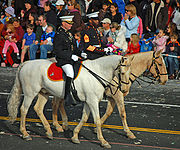
- Cream dun, Cremello dun or linebacked cremello: a blue-eyed cream horse also carrying the dun gene. The primitive markingsPrimitive markingsPrimitive markings among domestic horses are a group of hair coat markings and qualities associated with primitive breeds, and the dun coat color family in particular. All dun horses possess at least the dorsal stripe but the presence of the other primitive markings varies...
associated with the dun color are usually quite visible, especially on horses with a bay or black base coat. - Smoky grulla, silver grulla or smoky black dun: a black-based coat with one cream allele and at least one dun allele. The effect is of an extra-pale grulla.
- Double-cream champagne: any blue-eyed cream horse that also carries the champagne gene. The champagne traits are, in the few known individuals, not visible. The skin is quite pink.
- Amber cream or Buckskin champagne: a bay-based coat with one cream allele and at least one champagne alleleChampagne geneThe champagne gene is a simple dominant allele responsible for a number of rare horse coat colors. The most distinctive traits of horses with the champagne gene are the hazel eyes and pinkish, freckled skin, which are bright blue and bright pink at birth, respectively...
. The skin and eyes have champagne traits such as skin mottling, while the coat is a pale buff color. The points are a soft, pale grayish-chocolate. - Classic cream or Smoky black champagne: a black-based coat with one cream allele and at least one champagne allele. is also an acceptable term. Like an amber cream, they retain champagne traits in the skin and eyes, and range from pale buff to pale chocolatey-gray. Even though the coat is black-based, the mane and tail tend to be darker.
- Gold cream: chestnut-based coat with one cream allele and at least one champagne allele. Formerly referred to as "ivory champagne." The champagne traits remain in the skin and eyes, and the coat is an all-over ivory color.
- Sable cream or Brown buckskin champagne: brownSeal brown (horse)Seal brown is a hair coat color of horses characterized by a near-black body color; with black points, the mane, tail and legs; but also reddish or tan areas around the eyes, muzzle, behind the elbow and in front of the stifle...
-based coat with one cream allele and at least one champagne allele. The coat color falls between amber and classic cream. - Silver buckskin: bay-based coat with one cream allele and at least one silver dapple allele. The effect varies, as silver dapple does not act on red coats, but the buckskin's golden tone is somewhat lost.
- Silver smoky black: black-based coat with one cream allele and at least one silver allele. The effect varies from chestnut-like to silver black-like. Lighter eyes can help with identification.
Inheritance and expression

Locus (genetics)
In the fields of genetics and genetic computation, a locus is the specific location of a gene or DNA sequence on a chromosome. A variant of the DNA sequence at a given locus is called an allele. The ordered list of loci known for a particular genome is called a genetic map...
is on exon
Exon
An exon is a nucleic acid sequence that is represented in the mature form of an RNA molecule either after portions of a precursor RNA have been removed by cis-splicing or when two or more precursor RNA molecules have been ligated by trans-splicing. The mature RNA molecule can be a messenger RNA...
2 of the MATP
SLC45A2
Membrane-associated transporter protein also known as solute carrier family 45 member 2 or melanoma antigen AIM1 is a protein that in humans is encoded by the SLC45A2 gene.-Function:...
gene; a single nucleotide polymorphism
Single nucleotide polymorphism
A single-nucleotide polymorphism is a DNA sequence variation occurring when a single nucleotide — A, T, C or G — in the genome differs between members of a biological species or paired chromosomes in an individual...
results in an aspartic acid
Aspartic acid
Aspartic acid is an α-amino acid with the chemical formula HOOCCHCH2COOH. The carboxylate anion, salt, or ester of aspartic acid is known as aspartate. The L-isomer of aspartate is one of the 20 proteinogenic amino acids, i.e., the building blocks of proteins...
-to-asparagine
Asparagine
Asparagine is one of the 20 most common natural amino acids on Earth. It has carboxamide as the side-chain's functional group. It is not an essential amino acid...
substitution
Missense mutation
In genetics, a missense mutation is a point mutation in which a single nucleotide is changed, resulting in a codon that codes for a different amino acid . This can render the resulting protein nonfunctional...
(N153D). The DNA test offered by various laboratories detects this mutation. The MATP gene encodes a protein
Protein
Proteins are biochemical compounds consisting of one or more polypeptides typically folded into a globular or fibrous form, facilitating a biological function. A polypeptide is a single linear polymer chain of amino acids bonded together by peptide bonds between the carboxyl and amino groups of...
illustrated to have roles in melanogenesis in human
Human
Humans are the only living species in the Homo genus...
s, mice
Mouse
A mouse is a small mammal belonging to the order of rodents. The best known mouse species is the common house mouse . It is also a popular pet. In some places, certain kinds of field mice are also common. This rodent is eaten by large birds such as hawks and eagles...
, and medaka. Mice affected by a condition homologous to cream exhibit irregularly shaped melanosome
Melanosome
In a biological cell, a melanosome is an organelle containing melanin, the most common light-absorbing pigment found in the animal kingdom.Cells that synthesize melanins are called melanocytes, and also the retinal pigment epithelium cells, whereas cells that have merely engulfed the melanosomes...
s, which are the organelles within melanocytes that directly produce pigment.
Genes in horses such as Frame
Lethal white syndrome
Lethal white syndrome , also called overo lethal white syndrome , lethal white overo , and overo lethal white foal syndrome , is an autosomal genetic disorder most prevalent in the American Paint Horse...
and Sabino1
Sabino horse
Sabino is a group of white spotting patterns in horses that affect the skin and hair. A wide variety of irregular color patterns are accepted as sabino. In the strictest sense, "sabino" refers to the white patterns produced by the Sabino 1 gene, for which there is a DNA test...
produce white spotting by interrupting or limiting the migration of melanocytes from the neural crest
Neural crest
Neural crest cells are a transient, multipotent, migratory cell population unique to vertebrates that gives rise to a diverse cell lineage including melanocytes, craniofacial cartilage and bone, smooth muscle, peripheral and enteric neurons and glia....
, while the cream mutation affects the nature of the pigments produced by melanocytes. Therefore the skin, eyes, and hair of horses with the cream mutation do not lack melanocytes, melanosomes, or melanins, but rather exhibit hypomelanism.
Prior to the mapping of the cream gene, this locus was titled C for "color". There are two alleles in the series: the recessive, wildtype
Wild type
Wild type refers to the phenotype of the typical form of a species as it occurs in nature. Originally, the wild type was conceptualized as a product of the standard, "normal" allele at a locus, in contrast to that produced by a non-standard, "mutant" allele...
allele C and the incomplete dominant CCr. The CCr allele represents the N153D MATP mutation.
- C/C recessive homozygotesZygosityZygosity refers to the similarity of alleles for a trait in an organism. If both alleles are the same, the organism is homozygous for the trait. If both alleles are different, the organism is heterozygous for that trait...
are not affected by cream and have no true cream traits. - C/CCr heterozygotes have one cream allele, and one wildtype non-cream allele. Only red pigment in the hair is diluted, as seen in buckskins and palominos.
- CCr/CCr homozygotes (homozygous creams) have no wildtype non-cream alleles. The red and black pigment in the hair are diluted to cream, the eyes are light blue and the skin is rosy pink.
Cream was first formally studied by Adalsteinsson in 1974, who reported that the inheritance of palomino and buckskin coat colors in Icelandic horses followed a "semi-dominant" or incomplete dominant model. Adalsteinsson also noted that in heterozygotes, only the red pigment (pheomelanin
Melanin
Melanin is a pigment that is ubiquitous in nature, being found in most organisms . In animals melanin pigments are derivatives of the amino acid tyrosine. The most common form of biological melanin is eumelanin, a brown-black polymer of dihydroxyindole carboxylic acids, and their reduced forms...
) was diluted.
The discovery that the palomino coat color was inextricably linked to the cream coat color was very significant. At one time, double dilutes, particularly cremellos, were barred from registration by many breed organizations. Cremello was thought by some to be a white or albino coloring and a potential genetic defect. There also were known health implications of albinism in humans, and cultural prejudices; while a heroic figure such as Roy Rogers
Roy Rogers
Roy Rogers, born Leonard Franklin Slye , was an American singer and cowboy actor, one of the most heavily marketed and merchandised stars of his era, as well as being the namesake of the Roy Rogers Restaurants franchised chain...
rode a golden palomino, the "Albino" in Mary O'Hara
Mary O'Hara (author)
Mary O'Hara Alsop was an American author and screenwriter.-Biography:Mary O'Hara Alsop was born July 10, 1885 in Cape May Point, New Jersey, the third child of Reverend Dr. Reese Fell Alsop and Mary Lee Spring. O'Hara, who was named after her maternal grandmother, Mary O'Hara Spring , grew up in...
's Thunderhead portrayed a horse with a freakish defect. These coat colors carried vastly different cultural significance. Some of the research that took place nearly thirty years after Adalsteinsson's studies was directly supported by breed registries that barred blue eyed creams.
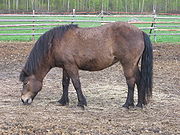
Cryptic creams
The cream gene's preferential effect on red pigment has not yet been explained. The champagne dilution affects both black and red pigments equally, the silver dapple affects only black pigment, and pearl exhibits a recessive mode of inheritance and only affects red pigment. Unlike the cream gene, pearl does not seem to affect the mane and tail to a greater extent than the body coat, a feature of cream that is most vividly illustrated in the palomino coat color. This characteristic of the cream gene is also unexplained. The disparity in effects on red and black pigments is easy to identify in buckskins, with their black points, but it is also visible in CCr/CCr homozygotes: perlinos (homozygous cream on a bay coat) often retain points that are a darker shade of cream.This unusual feature enables what are called cryptic creams. A certain percentage of dark bay, seal brown
Seal brown (horse)
Seal brown is a hair coat color of horses characterized by a near-black body color; with black points, the mane, tail and legs; but also reddish or tan areas around the eyes, muzzle, behind the elbow and in front of the stifle...
, and black
Black (horse)
Black is a hair coat color of horses in which the entire hair coat is black. Black is a relatively uncommon coat color, and novices frequently mistake dark chestnuts or bays for black. However, some breeds of horses, such as the Friesian horse, Murgese and Ariegeois are almost exclusively black...
horses exhibit such subtle dilution of their coats as to be misregistered. In the study that mapped the cream gene, three horses registered as seal brown, dark bay or bay were actually smoky black and buckskin. This is one way by which the cream gene is transmitted through generations without being identified. Horses born palomino, buckskin, and smoky black, but also carry the gray
Gray (horse)
Gray or grey is a coat color of horses characterized by progressive silvering of the colored hairs of the coat. Most gray horses have black skin and dark eyes; unlike many depigmentation genes, gray does not affect skin or eye color Their adult hair coat is white, dappled, or white intermingled...
gene, have a hair coat that turns white as they age and are usually registered as "gray" rather than as their birth color. This is particularly a common occurrence in the Connemara
Connemara
Connemara is a district in the west of Ireland consisting of a broad peninsula between Killary Harbour and Kilkieran Bay in the west of County Galway.-Overview:...
breed. Horses sold after turning fully gray may surprise breeders by producing golden or cream offspring.
This effect - stronger expression on red pigment - is also seen in coat pattern genes in horses. In general, white markings
Horse markings
Markings on horses usually are distinctive white areas on an otherwise dark base coat color. Most horses have some markings, and they help to identify the horse as a unique individual. Markings are present at birth and do not change over the course of the horse's life...
are more pervasive in chestnuts than in non-chestnuts, to the extent that homozygous non-chestnuts (which carry the "Extension" (E) gene and may also carry the Agouti gene) were more modestly marked than non-chestnuts heterozygous for the E gene. This effect has also been identified and studied in the Leopard complex
Leopard complex
The leopard complex is a group of genetically-related coat patterns in horses. These patterns range from progressive increases in interspersed white hair similar to graying or roan to distinctive, Dalmatian-like leopard spots on a white coat. Secondary characteristics associated with the leopard...
patterns.

Analogous conditions in other animals
The MATP gene is highly conserved, especially among mammals. The human MATP gene is 82% identical to the mouse MATP gene, 79% identical to the rat MATP gene, 35% to the zebrafish version, and 30% identical to the fruitfly MATP gene. The gene is best known in humans as being the location of a mutation that results in human type IV oculocutaneous albinism (OCA4). Type IV oculocutaneous albinism, like other types of human albinism, results in hypopigmentation of the skin and eyes, with increased rates of skin cancer and reduced visual acuity. None of these effects are associated with the equine cream gene. Other human MATP polymorphisms result in normal pigment variations, specifically fair skin, light eyes, and light hair in Caucasian populations.A polymorphism on the mouse MATP gene is known to be the cause of the underwhite coat color phenotype. The phenotype was first identified in the 1960s, and since then has been mapped successfully. Affected individuals have a reduction in eye and coat pigmentation, and irregularly shaped melanosomes.
See also
- Equine coat color geneticsEquine coat color geneticsEquine coat color genetics determine a horse's coat color. There are many different coat colors possible, but all colors are produced by the action of only a few different genes. The simplest genetic default color of all domesticated horses can be described as either "red" or "non-red", depending...
- Equine coat colorEquine coat colorHorses exhibit a diverse array of coat colors and distinctive markings. A specialized vocabulary has evolved to describe them.While most horses remain the same color throughout life, a few, over the course of several years, will develop a different coat color from that with which they were born...
- White (horse)White (horse)White horses are born white and stay white throughout their life. White horses may have brown, blue, or hazel eyes. "True white" horses, especially those that carry one of the dominant white genes, are rare...
- Gray (horse)Gray (horse)Gray or grey is a coat color of horses characterized by progressive silvering of the colored hairs of the coat. Most gray horses have black skin and dark eyes; unlike many depigmentation genes, gray does not affect skin or eye color Their adult hair coat is white, dappled, or white intermingled...
- PalominoPalominoPalomino is a coat color in horses, consisting of a gold coat and white mane and tail. Genetically, the palomino color is created by a single allele of a dilution gene called the cream gene working on a "red" base coat...
- Buckskin (horse)
- Dun geneDun geneThe dun gene is a dilution gene that affects both red and black pigments in the coat color of a horse. The dun gene has the ability to affect the appearance of all black, bay, or chestnut -based horses to some degree by lightening the base body coat and suppressing the underlying base color to the...
- Champagne geneChampagne geneThe champagne gene is a simple dominant allele responsible for a number of rare horse coat colors. The most distinctive traits of horses with the champagne gene are the hazel eyes and pinkish, freckled skin, which are bright blue and bright pink at birth, respectively...
- Silver dapple geneSilver dapple geneThe silver dapple gene is a dilution gene that affects the black base coat color. It will typically dilute a black mane and tail to flaxen, and a black body to a shade of brown or chocolate. It is responsible for a group of coat colors in horses called "silver dapple" in the west, or "taffy" in...
- AlbinismAlbinismAlbinism is a congenital disorder characterized by the complete or partial absence of pigment in the skin, hair and eyes due to absence or defect of an enzyme involved in the production of melanin...
- Leucism
- Lethal white syndromeLethal white syndromeLethal white syndrome , also called overo lethal white syndrome , lethal white overo , and overo lethal white foal syndrome , is an autosomal genetic disorder most prevalent in the American Paint Horse...

